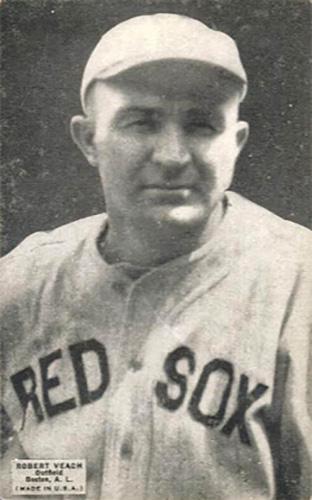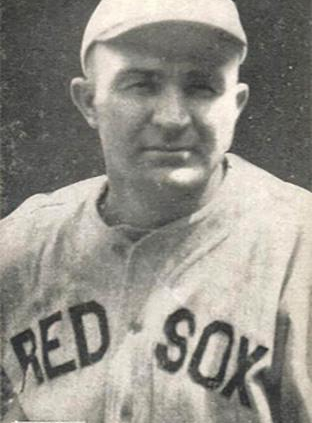July 28, 1924: Browns’ protest is upheld after falling to Red Sox
 Baseball games are frequently protested by managers and teams on the wrong side of controversial calls, but it’s rare that a protest is upheld and a game’s result is impacted. One such successful protest occurred during the 1924 season, following an umpire’s erroneous ruling after a series of substitutions.
Baseball games are frequently protested by managers and teams on the wrong side of controversial calls, but it’s rare that a protest is upheld and a game’s result is impacted. One such successful protest occurred during the 1924 season, following an umpire’s erroneous ruling after a series of substitutions.
The scoreboard read “Boston Red Sox 10, St. Louis Browns 5,” but it is listed as, in effect, a tie. A no-decision. July 28, 1924, was the date. The game was in St. Louis, a Monday afternoon Ladies Day game that drew 7,500 to Sportsman’s Park. The Browns were in fourth place and the Red Sox in sixth.
The home-plate umpire was Brick Owens, who had umpired his first American League game in 1908. He led a three-arbiter crew that also included George Moriarty and Pants Rowland.
George Sisler was the Browns skipper and Lee Fohl managed the Red Sox. The starting pitchers were two right-handers, St. Louis’s Urban Shocker and Boston’s Bill Piercy. Both starters pitched well.
Boston scored first when leadoff batter (and third baseman) Danny Clark walked, took second on second baseman Bill Wambsganss’s sacrifice bunt, and came home after left fielder Bobby Veach singled to center. Despite a single and a walk in the St. Louis first, a double play helped Piercy escape with a 1-0 lead.
Another leadoff walk and a double put Boston runners on second and third with nobody out in the second, but Shocker struck out the next three batters.
Piercy held the one-run lead until the Browns tied the score, 1-1, in the bottom of the fifth. With one out, shortstop Wally Gerber singled on a slow roller. Shocker’s sacrifice advanced him to second base. Right fielder Jack Tobin grounded to Clark at third base, but Clark’s throw to first went wild and Gerber scored the tying run.
The tie remained until the top of the seventh, when the Red Sox singled three times in a row with one out, loading the bases on the third one when the Browns neglected to cover first on Piercy’s bunt back to Shocker. Clark grounded to second baseman Marty McManus, who threw home and cut down the lead runner. But Wambsganss drove in one run on an infield single to third base and Veach singled to left, driving in two more. It was 4-1, Boston.
With one out and runners on first and third, Boston’s Jack Quinn, at age 41 the oldest regular member of an AL roster in 1924, relieved Piercy in the bottom of the seventh. Left fielder Joe Evans hit a sacrifice fly that made it 4-2.
Shocker had been lifted for a pinch-hitter in the St. Louis seventh, and George Grant came in to pitch for St. Louis. Right fielder Ike Boone doubled for Boston, leading off the eighth, was sacrificed to third, and scored two batters later on shortstop Howie Shanks’ triple to the fence in left-center.
St. Louis rallied against the spitballer Quinn with a single, force out, and two more singles in the bottom of the eighth. The third single was Hank Severeid’s hit to load the bases with one out, and the Browns sent in Norm McMillan to run for Severeid, a move that, as it happened, was significant to the game’s outcome.
With the bases loaded, Ernie Wingard – a left-handed pitcher who batted .232 with seven home runs in his four-year major-league career – pinch-hit for Gerber. He “dropped a Texas Leaguer in center,” a single driving in Baby Doll Jacobson.1 Syl Simon pinch-hit for Grant and walked, cutting the deficit to one run. Alex Ferguson replaced Quinn and got out of the inning on a foul caught by the catcher and a popup to first base.
The lead was Boston’s at 5-4 after 8½ innings, but St. Louis tied it up in the bottom of the ninth on a two-out double to right field by Gene Robertson, driving in McManus, who had walked.
With Robertson on second, McMillan, who had remained in the game at short, strode up to the plate to hit. Umpire Owens would not permit McMillan to bat, though, and ordered catcher Tony Rego, who had replaced Severeid, to bat instead.
Owens and Sisler conferred for “several minutes,” but Owens insisted that Rego bat.2 Rego grounded out to short, and the game went into extra innings.
The Red Sox immediately pounced on the flustered Browns for two walks, a hit batsman, and three hits in the top of the 10th, yielding five runs against two St. Louis relievers. Boone’s triple drove in the go-ahead run, and Shanks’ bases-loaded walk, Ferguson’s two-run single, and pinch-hitter Johnny Heving’s RBI groundout gave the Red Sox insurance.
McMillan did get his chance in the 10th; he led off and grounded out, third to first. Ferguson held St. Louis scoreless, and the game was seemingly over, a 10-5 Red Sox win.
Browns business manager Bill Friel immediately announced he would send a telegram to AL President Ban Johnson to protest the game, citing Owens’ refusal to let McMillan bat after Robertson in the ninth inning.
Why would Owens refuse McMillan? The Browns had substituted for two of their starting position players in the eighth inning: Wingard pinch-hit for shortstop Gerber and McMillan pinch-ran for catcher Severeid. Severeid had followed Robertson in the batting order.
In the top of the ninth, McMillan played shortstop in place of Gerber, and Rego took Gerber’s place catching and batting eighth. The substitutions moved St. Louis’s catcher from seventh to eighth in the batting order, and the shortstop from eighth to seventh.
When McMillan attempted to bat in the ninth, Owens had mistakenly thought Rego – catching, as had been Severeid – should be batting.
The Boston Herald took it as fact that Owens had been wrong. concluding the first paragraph of its game story thus: “There is a possibility that the Browns will protest, inasmuch as Owens insisted that the Browns bat out of turn in the ninth inning.”3
After the game, Owens “later admitted to newspaper men that he had erred.”4
On August 17 Johnson issued his ruling. The victory was taken away from Boston and it was ordered that the game be “replayed during the first visit of Boston to St. Louis.”5
The July 28 game was a no-decision.
The game was replayed in its entirety as the second game of a September 13 doubleheader. On that Saturday afternoon, Dixie Davis of the Browns shut out the Red Sox 6-0, in the first game. The second game – the game replacing the June 28 game – resulted in a back-and-forth, high-scoring 13-11 Red Sox victory. Owens was the plate umpire once more. The Globe-Democrat allowed that “Owens didn’t make any mistakes yesterday, but the Browns made plenty of them.”6 They did commit four errors in the second game. Alex Ferguson got the win.
The season finished with the Browns still in fourth but the Red Sox in seventh. Owens continued to serve as an American League umpire through the 1937 season, completing 25 years of service.
Acknowledgments
This article was fact-checked by Jim Sweetman and copy-edited by Len Levin.
Photo credit: Trading Card DB.
Sources
In addition to the sources cited in the Notes, the author consulted Baseball-Reference.com and Retrosheet.org. This game is expanded from a brief account in Bill Nowlin, Red Sox Threads (Burlington, Massachusetts: Rounder Books, 2008).
https://www.baseball-reference.com/boxes/SLA/SLA192407280.shtml
https://www.retrosheet.org/boxesetc/1924/B07280SLA1924.htm
Notes
1 Martin J. Haley, “Red Sox Score Five Runs in Tenth to Defeat Browns, 10 to 5,” St. Louis Globe-Democrat, July 29, 1924: 5.
2 Haley.
3 “Fohls Unleash Furious 5-Run Attack in 11th and Trim Brown, 10-5,” Boston Herald, July 29, 1924: 8. Another headline – on the same page – got the inning correct: “Red Sox Detonate in 10th and Blow St. Louis All Over Missouri.”
4 “Browns Protest Red Sox Game,” The Sporting News, July 31, 1924: 1.
5 “Browns Win Protest,” New York Times, August 18, 1924: 9.
6 Martin J. Haley, “Browns Lose, 13-11, and Win, 6-0,” St. Louis Globe-Democrat, September 14, 1924: 13.
Additional Stats
Boston Red Sox 10
St. Louis Browns 5
10 innings
(Game declared a no-decision)
Sportsman’s Park
St. Louis, MO
Box Score + PBP:
Corrections? Additions?
If you can help us improve this game story, contact us.


